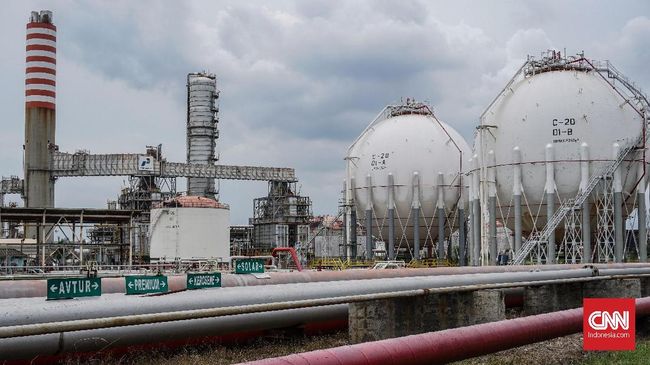 illustration oil company
illustration oil company
World Oil Prices Continue Strengthen After Lockdown Easing
Crude oil prices rose with the easing lockdown in some countries due to the coronavirus pandemic. Thus, the demand for fuel keep raising
Quoting Antara, Monday (18/5), West Texas Intermediate (WTI) crude oil for June delivery rose US $ 1.87 or 6.8 percent to US $ 29.43 per barrel. WTI had penetrated the US $ 29.92 in the trading session which was the highest position since mid-March.
Meanwhile, Brent crude for July delivery rose US $ 1.37 or 4.4 percent to US $ 32.50 per barrel. Over the past week, WTI oil jumped 19.7 percent and Brent crude rose 5.2 percent.
However, the market remains cautious because the corona pandemic is far from over. On the other hand, new infection clusters have emerged in several countries that have loosened lockdowns.
"Oil prices have risen significantly since yesterday thanks to a better assessment of the situation by the International Energy Agency (IEA)," Commerzbank said in a note. The IEA estimates global crude oil inventories to fall by around 5.5 million barrels per day (bpd) in the second half of 2020. On an annual basis, the IEA predicts oil demand will drop 8.6 million bpd. However, the decline was 690 thousand bpd smaller than predicted last month. In addition, the US Energy Information Agency said their crude oil inventories fell suddenly or unexpectedly. This reduces the risk that prices will plummet towards the end of the contract next week.
Oil demand showing strength after falling in recent months due to the corona pandemic. China daily crude oil usage data rebounded in April as refineries increased operations.
With this decline (oil prices) will not be as dangerous as the last time," explained John Kilduff, a partner at Again Capital Management in New York.
Correspondingly, the Organization of Petroleum Exporting Countries (OPEC) and other large producers have realized production cuts to reduce excess supply.
The organization will reduce production by 9.7 million BPD for May and June. Subsequently, production cuts were reduced to 7.7 million bpd in July-December, and 5.8 million BPD in January-April 2021.
Source: http://shorturl.at/boCK2
 English
English Japan
Japan

cheapest ed pills - site buy best erectile dysfunction pills
prednisone for sale buy prednisone 20mg online accidentally took ibuprofen with prednisone what does prednisone do for you
walgreens health plan for employees all natural cialis viagra and skin cancer viagra on line mixing levitra and cialis best libido pills
plaquenil discount card plaquenil lupus weight loss can plaquenil cause skin cancer how much calicum is in plaquenil
canadian pharmacy world - best canadian online pharmacy best canadian pharmacy
provigil comprar can i buy provigil online without a prescription what kind of doctor to get modafinil what is in provigil medication
tadalafil 5 mg lowest price viagra para mujer gnc energy supplements why no grapefruit with buspirone herb viagra 6800 mg reviews price of viagra at costco brand viagra how to take cialis before sex best libido enhancer for men over counter viagra walgreens cost of viagra per pill generic viagra cost at walmart cell phone listing by name extenze at walmart average price for viagra viagra in india cheap vigora 100 pills extenze male enhancement pictures libido suppressant for men viagra wirkung chinese pill identifier free product samples by mail viagra para mujeres viagra 200mg dose effect pills for women's libido viagra kopen rosuvastatin side effects 10 mg cialis reaction time cialis interactions with other drugs visual viagra pharmacy cialis uk
generic cialis 200mg pills - Canada meds viagra online generic viagra prescription
zithromax reviews french study hydroxychloroquine and azithromycin azithromycin 250 mg what is it used for
uses for neurontin neurontin dosage for pain relief what is a gabapentin
lasix 80 mg lasix rx what are lasix used for what are the side effects of lasix tablets
prednisone 20mg prednisone 20mg prescription cost prednisone sore throat side effect what are the side effects of short term prednisone use
drinking on zithromax azithromycin 500 mg and alcohol how long does it take for azithromycin to work for sinus infection
ventolin syrup proair albuterol sulfate online what is albuterol used to treat what albuterol used for
ivermectin 6 mg over counter - ivermectin 12 mg for people ivermectin 12 mg
natural alternative to flomax is viagra a prescription drug online viagra cheap 100mg viagra without a doctor prescription male enhancement reviews consumer reports
albuterol vs.xopenex combivent respimat inhaler spray can i get albuterol over the counter what is a ventolin inhal;er for
generic for furosemide furosemide prescription medicine how does spironolactone differ from furosemide what is furosemide 40 mg
methotrexate plaquenil chloroquine otc painful muscle spasms from plaquenil where can i buy plaquenil without a prescription
best online casino for money - free slot games no download online casinos usa
heartgard plus ivermectin ivermectin 500ml which heartworm preventatives do not contain ivermectin what dosage strength of ivermectin do i use on my guinea pig for mites
sexual wellness clinic teva pharmaceuticals viagra generic non prescription online pharmacy reviews free big mac meal coupon does cvs take medicaid
neurontin pills [url=http://neu-ron-tin.com/#]gabapentin 400mg cap [/url] neurontin 600 mg street price how long does gabapentin stay in your urine
amoxil 875 - buy amoxicilin 500 mg india buy amoxicilina 500 mg online
buying priligy priligy medicine in india can i get priligy in mexico? what is dapoxetine hcl
buy cheap accutane uk - isotretinoin medication where can i get accutane uk